Story and Photos by Roberto Motta

The subject of this article, this Alfa T33/2, is owned by Marco Cajani.
This Alfa Romeo T33/2 is powered by the two-litre Alfa Romeo V8, still with its original 240 horsepower and in its original 1967 European
Mountain Championship configuration. It is the first of the tipo, and the 33 TT SC12 Turbo was the last.
Alfa Romeo’s history of racing started before World War I, and continued in 1950 and 1951 when the Type 158 and ˜Type 159 won the first two World F1 Championships while the Disco Volante (6C 3000 CM) sportscar was still competitive in 1954. Despite the successes, Alfa Romeo decided to stop its racing in order to focus its attention on the production of their 1900 and 1300 cc street cars.
Some years later, the Italian factory decided to return to sports car racing with the Giulietta SZ, and then with fantastic Giulia TZ 1 and TZ 2 (TZ= Tubolare Zagato; Tubolare=tubular frame and Z=Zagato). The TZs had a light alloy body, disc brakes, and independent suspension for superior handling and performance.
The TZ was built under the technical direction of Carlo Chiti of Autodelta, Alfa’s new competition department. After the TZ, the Autodelta produced the Giulia 1600 GTA and also this car was a dominant force in many racing Championships.
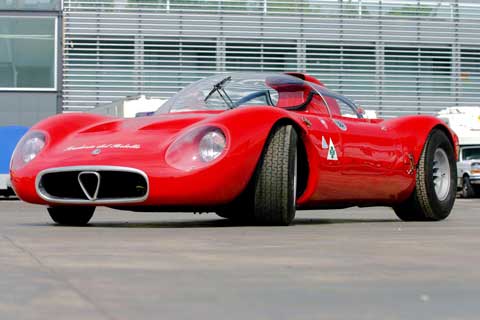
The success of the GTZ led to the development of a sports racer.
During the summer 1966, the Alfa Romeo’s manager, Giuseppe Luraghi, decided to create a new Sport 2 liters for the World Constructors Championship.
The new Sport-Prototype was a two-seater which was given the codename ‘105.33’ but became known as the ’33’ . Original factory drawings indicate that since it was a two liter, it was also tagged the T33/2, later creating some confusing as to how to designate the ‘series 2’ cars in 1968.
In the Autodelta workshop, Carlo Chiti developed a 1600cc engine version, and then used all the experience he had already gained from the 1500 V8 ATS Grand Prix car, designed and produced the new Alfa Romeo V8 engine. The engine was installed in a rear engine chassis, which was a development of the OSI/Scarebo experimental show cars.
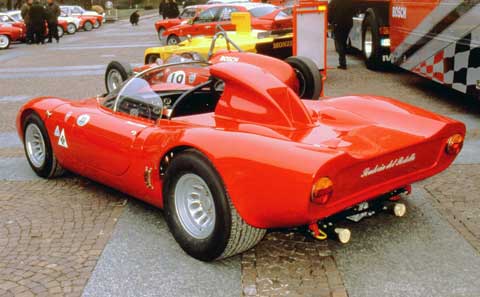
The large intake behind the driver looked like a periscope, and the cars gained the nickname “periscopica” Alfas.
On the 7th January 1967, The 33/2 had its shakedown at Monza circuit, where Teodoro Zeccoli drove the car in secret tests exclusively on the Alfa Romeo private track at Balocco. It was not a good day for the Alfa Romeo and due to ice on the track, or lack of brakes, Zeccoli lost control of the car. The car crashed and then burned. Fortunately, before the impact, the driver was thrown clear from the cockpit but Zeccoli remained in the hospital for two weeks. It is believed that this car was chassis 002.
Three months later, Alfa tried again. On 6th March, the 33/2 ‘periscopica’ was officially introduced to the press in the presence of the Ing. Carlo Chiti and the drivers Roberto Bussinello, Ignazio Giunti, Teodoro Zeccoli, and Giacomo Russo (Geki).
During the launch, Luraghi said to the journalists: “This car is the official announcement of the return of Alfa Romeo to the sport of racing with a car purposely constructed. In the best tradition Alfa Romeo is ready to enter sportingly into battle.
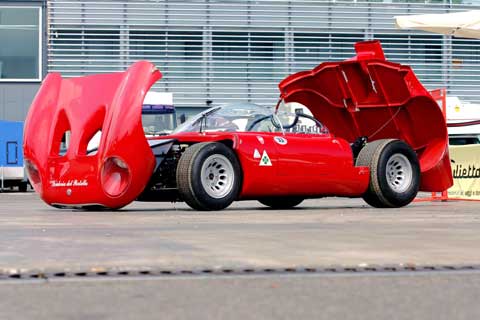
Easy access to the mechanicals was essential for competition.
Only a week later, on 12th March, the 33/2 driven by Zeccoli, triumphed at Fluron, a small town near Liege, in Belgium. Alfa took two cars to the event, and it is believed that chassis 75033-001 was driven by Zeccoli.
In this article we would like present to the reader the car that won at Fluron and is currently owned by Marco Cajani. This car is still in Italy near Milano, and Cajani has all the documents which confirm that this 33/2 was used at Fluron and in other tests, for example, during the trials for the Targa Florio.
When Cajani saw this 33/2 at Alfa Romeo in 1986, and negotiated to purchase it, the car had a complete, original chassis with suspension, engine and all the parts except the body. Some year later, after long searches throughout Europe, Cajani was ready to rebuild the car.
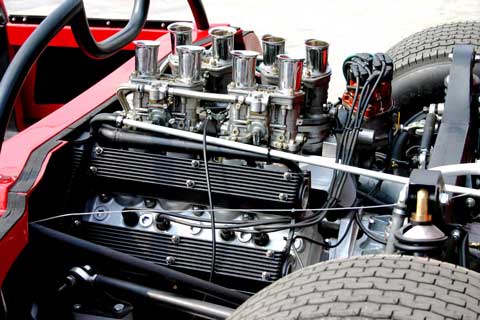
The two liter V8 produced 240 hp.
The Alfa T33/2 is dominated by the presence, on the rear flat deck, of a huge snorkel air intake, and for this reason this car immediately was given the nickname ‘Perisopica’. The snorkel’s function is to feed cool air to the engine and to the inboard rear brakes.
The first Tipo 105.33, has an unusual chassis that was designed using aeronautical techniques and was built by an aircraft company, Aereaonautica Sicula. The frame is made from three pieces of aluminum tubing 1520 mm long and 200 mm in diameter. The pieces are riveted together and form an ‘H’. Inside at the lateral pieces, there are a synthetic fuel tanks with the capacity of 98 litres (25.88 gal).
At the front, there is a magnesium casting that connects the two ends and provides space to mount the pedals, master cylinder and the steering gear.
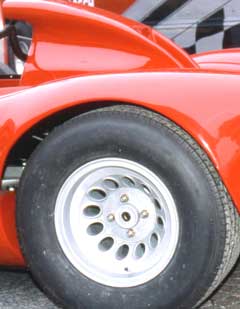
The front suspension assemblies use transverse swinging arm, spring and shock absorbers that work vertically, and an anti roll bar. The rear suspension assemblies use spring and shock absorbers that are mounted in an inclined position, anti roll bar and a longitudinal control arm.
The engine is a 90-degree V8 with chain-driven twin-overhead camshafts on each bank with an aluminum cylinder block and wet liners. The crankshaft has five main bearings and is lubricated by dry sump system. The valves, two per cylinder, are closed by triple coil valve springs. Bore and stroke are 78 mm x 52,2 mm, total capacity is 1995.4 cc (121.7 cu in). With a compression ratio of 11.1:1, fed by four huge 46 IDF2 Webers carburetors and with only one plug per cylinder, the Alfa Romeo V8 power unit developed a power output of 230-240 bhp at 8000 rpm.
The 33/2-Fleron uses an manual six speed transmission and mechanical limited-slip differential. This special transmission was made by Alfa Romeo. The car has four ventilated disc brakes, with double-piston brake calipers. The front disks are mounted at the wheels and the rear disks are mounted inboard with the differential. The wheels are magnesium and the front tires measure 525 x 13″ and the rear 600-700 x13″.
The car declared a weight of 580 kg (1278.68 lbs), a wheelbase of 2250 mm, overall width of 1380 mm, overall length 3600 mm, front track of 1325 mm and rear track of 1690 mm.
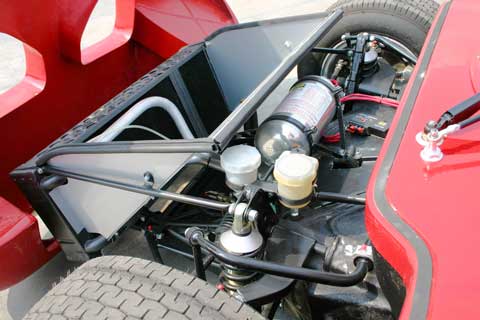
Front suspension with spring over shock absorbers and anti–roll bar.
After the restoration, Marco Cajani decided to use the car carefully, and not to race it, because this 33/2 is a wonderful rarity and also because it has a lot of magnesium parts, a very precious and delicate material. (When the first car burned at Monza, the fire refused to go out as the magnesium kept re-igniting.)
“This car is able to exceed 260 km/h (161.6 mph),” Cajani told us, “so we have had to rebuild it with safety and maintenance in mind.” Cajani said that during the restoration, all the magnesium parts were x-rayed, in order to find any anomalies. “Also, following the advice of Ing. Chiti, we have decided to use the Weber carburetors, (instead of fuel injection) so as to conserve the original qualities of the engine. Now, after a lot of time, the car is working perfectly,”continued Cajanni. “It is our intention to drive the T33/2 on those circuits on which it has written great history.”
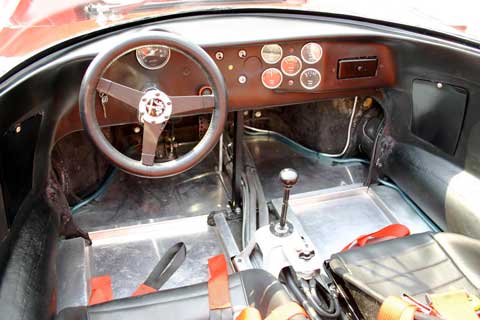
Left hooker here, later cars were right hand drive.
Cajani is pleased with the performance as well. “On the track the 33/2 reveals to the driver to be a car with a true sporty vocation with a generous engine that, over the 3500 rpm, can be pushed with brio without any decrease of vigor in all the rpm ranges“.
In summary, the T33/2 is a car of compact external dimensions with substantial attributes and values that are encoded in Alfa Romeo DNA.
June 20
After some discussion regarding the use of the number ‘/2’ after the Tipo 33, Roberto Motta has sent us verification of the 33/2 question. Initially, the ‘2’ did mean ‘two liters’ and was indicated as such on 1967 factory drawings and brochures which he has sent to us. It was previously thought that the T33/2 designation was applied only to the series 2 cars from 1968. Mr. Motta has proven otherwise.
Great article by Robert Motta on the original Alfa T33 Periscopio! Thanks for clearing up the origin on the 33/2 name too, as that was confusing at the time, as we all thought of it as 1st generation. Later, after the T33B berlinetta/spider, we fans called the ’70 chassis 33/2 also.
The article on the Alfa T33/2 is confusing to me.It makes it appear that this was the only car of the type.I was at Sebring on April 1 of 67 where I witnessed two of the type 33’s #65&66 lead the opening laps. I still have the photos I took of them. They were blindingly fast though apparently fragile as they soon secumbed. Can someone clear up what the difference is between the 33/2 Fleron and the two similar cars which I saw at Sebring.What ultimately became of those cars?
there wasn ‘t difference between the Fleron and the Sebring cars;They where Group 6 specifications cars and the real name was simply Alfa Roemo 33 .
Later in the season ( Rossfeld Hill Climb) at Group 7 lighter car appeared for Hill Climb.
The 2 for 33 – 2 was meaning the snd model type.